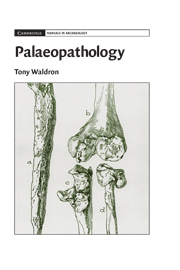Book contents
- Frontmatter
- Contents
- List of Figures
- Preface
- 1 Introduction and Diagnosis
- 2 Bone Metabolism and Pathology
- 3 Diseases of Joints, Part 1
- 4 Diseases of Joints, Part 2
- 5 Bone forming and DISH
- 6 Infectious Diseases
- 7 Metabolic Diseases
- 8 Trauma
- 9 Tumours
- 10 Disorders of Growth and Development
- 11 Soft Tissue Diseases
- 12 Dental Disease
- 13 An Introduction to Epidemiology
- Select Bibliography
- Index
- References
11 - Soft Tissue Diseases
Published online by Cambridge University Press: 05 June 2012
- Frontmatter
- Contents
- List of Figures
- Preface
- 1 Introduction and Diagnosis
- 2 Bone Metabolism and Pathology
- 3 Diseases of Joints, Part 1
- 4 Diseases of Joints, Part 2
- 5 Bone forming and DISH
- 6 Infectious Diseases
- 7 Metabolic Diseases
- 8 Trauma
- 9 Tumours
- 10 Disorders of Growth and Development
- 11 Soft Tissue Diseases
- 12 Dental Disease
- 13 An Introduction to Epidemiology
- Select Bibliography
- Index
- References
Summary
For the examination of soft tissue diseases, mummies come into their own, subject to the limitations that were mentioned briefly in Chapter 1 and which may need to be expanded upon here. The principal constraint is that, in most parts of the world, mummified remains are greatly in the minority and most palaeopathologists will spend most of their working lives dealing with human remains that have no soft tissue attached to them. There is then the problem that even in those cultures in which mummification, either direct or indirect, was the major means of disposing of their dead, the bodies may often lack the internal organs, and where they are present, it may be difficult to examine them without subjecting the mummy to an autopsy or to endoscopic examination. A full autopsy is – understandably – often not permitted because it is, by its nature, destructive and many archaeologists and museum curators are reluctant to permit valuable exhibits to be partially or completely destroyed. Modern imaging techniques such as CAT or MRI scanning permit non-destructive examination to be made but they are expensive and by no means available to all investigators, and certainly not on a large scale without special funding. Even when available, the results may not always be instructive because of changes in the tissues resulting either from the mummification or from natural decay.
- Type
- Chapter
- Information
- Palaeopathology , pp. 221 - 235Publisher: Cambridge University PressPrint publication year: 2008

